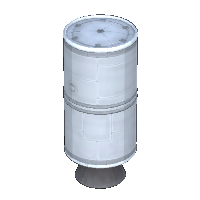RT-10 "Hammer" Solid Fuel Booster
| RT-10 "Hammer" Solid Fuel Booster | ||
| Solid rocket booster by Found lying by the side of the road | ||
| Radial size | Small, Radial mounted | |
| Cost | (total) | 400.00 |
| (dry) | 175.00 | |
| Mass | (total) | 3.563 t |
| (dry) | 0.750 t | |
| Drag | 0.2-0.3 | |
| Max. Temp. | 2000 K | |
| Impact Tolerance | 7 m/s | |
| Research | | |
| Unlock cost | 1 200 | |
| Since version | 0.7.3 | |
| Part configuration | solidBoosterRT-10_v2.cfg | |
| Maximum thrust | (1 atm) | 197.90 kN |
| (vacuum) | 227.00 kN | |
| Isp | (1 atm) | 170 s |
| (vacuum) | 195 s | |
| Fuel consumption | 15.83 | |
| Thrust vectoring | No | |
| Burn time | (1 atm) | 20.7 s |
| (vacuum) | 23.7 s | |
| Testing Environments | ||
| On the surface | No | |
| In the ocean | No | |
| On the launchpad | Yes | |
| In the atmosphere | Yes | |
| Sub-orbital | Yes | |
| In an orbit | Yes | |
| On an escape | No | |
| Docked | No | |
| Test by staging | Yes | |
| Manually testable | Yes | |
| Solid fuel | 375 | |
The RT-10 Solid Fuel Booster (also known as an SRB) is a solid rocket booster used to provide a short burst of additional thrust to a rocket. It comes as a single unit. The engine and fuel tank are one single part which means that it isn't possible increase the burn time for it by adding more fuel tanks.
Contents
Usage
RT-10's are one-shot rocket boosters often used to help get the massive bulk of a large multi-stage rocket off the ground. They burn at a constant thrust until they run out of fuel and then cease to work. Solid boosters have a better thrust-to-weight ratio than a liquid fuel rocket and tank, but lack a controllable throttle or the ability to extend the duration of the burn nor are they as efficient or powerful. It should be noted that boosters do not reduce the need for liquid fuel, as one must also take into account thrust to weight ratios.
The boosters can be mounted with radial decouplers, and it is usually a good idea to jettison spent boosters as they are quite heavy even when empty. Particular care must be taken to ensure they have finished burning before jettison as there is the risk that they will collide with the rest of the rocket as they continue to accelerate. Unlike their liquid fuelled counterparts, solid boosters cannot have additional fuel attached to them to provide a longer burn time, though you could use standard decouplers to have a sequence of solid boosters.
RT-10 Solid Fuel Boosters are prone to overheating, especially when large numbers are clustered together. The main ways to overcome this are by using custom staging to stagger the firing, and attaching additional parts that are not SRBs (typically struts and/or winglets) to act as heat sinks. These 'heat sinks' can provide extra functionality by holding the boosters more securely to the main rocket as well help provide additional control.
Description
| “ | While considered by some to be little more than "a trash bin full o' boom", The RT-10 is used in many space programs, whenever the need to save cash is greater than the need to keep astronauts alive. Use with caution, though. Once lit, solid fuel motors cannot be put out until the fuel runs out. — Jebediah Kerman's Junkyard and Spaceship Parts Co. |
” |
Trivia
Between 0.7.3 and 0.15.2, the RT-10 was of limited use, mainly for providing extra challenge or silliness related to its high thrust to weight ratio. In rare cases it provided a small performance boost from overcoming the sticky pad bug or getting a rocket up to ideal speed.
In 0.16, the RT-10 had a specific impulse (or Isp) of 442.4 s, higher than any other solid or liquid fuel rocket, making a useful, if situational, choice (especially during launch). However, its increased mass in 0.17 reduced its Isp to 212.4 s.
Changes
- Retextured
- Full mass increased from 1.8 to 3.5 kg; dry mass increased from 0.36 to 0.5 kg.
- Thrust increased from 130 to 250 (part rebalancing)
- New texture for the Solid Rocket Booster
- Initial Release
| ||||||||||||||||||||||||||||

